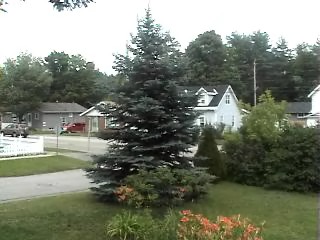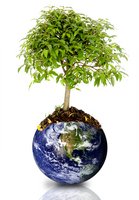Your Trees-Absorb-CO2
Trees Are Natural Purifiers
Not just for shelter and shade, trees-absorb-CO2 from the air. Consider different types-of-trees to plant around your home that will take advantage of the many benefits to be had.
Trees not only cool the planet by providing greenery to urban
areas, shade for our homes and streets, but they are also like natural air conditioners in the process.
By soaking up carbon dioxide, they purify the air we breath.
Your neighbor next door with no trees at all, may have his air conditioner running at the maximum.
Your home can be ten degrees cooler in the summer if you have shade trees.
Likewise, trees can reduce winter heating costs by as much as 15%, by sheltering you from bitter weather.
I was given a lovely blue-spruce 13 years ago, when it was a mere 3 feet in height. I never thought I would see it reach the height and fullness that it has today.
It is quite beautiful and we are considering asking our local hydro crew to come over with their crane, so that I can re-string
Christmas lights from the top down.
Not only does it provide shelter for the birds, it provides an excellent source of shade for other plants as well. Trees are also great water recyclers, which feed other plants.

The "little" Blue Spruce
Early Spring Is The Best Time To Plant Trees
Consider why you may want to plant certain types-of-trees in addition to the fact that trees-absorb-CO2.
Think of the tree-planting-benefits already mentioned, and relate that to locations around your property.
Is it for privacy?
Shelter from the elements?
Looking to attract birds?
Hint of color or focal point for your property?
Whatever your reason, you should consider if it's reasonable to plant certain types where you are.
Proper hardiness zone?
Will the root system interfere eventually with underground
pipes or wires?
Will the tree interfere eventually with overhead wiring?
You may or may not want a deciduous or evergreen tree.
Deciduous trees shed their leaves when the seasons change.
Evergreen trees keep their foliage year-round.
Deciduous trees include: Birch, Poplar, Beech, Oak, Maple, Hickory, Pecan
Take Time And Care When Planting - How to plant a tree
The rule is usually to dig the hole twice the diameter of the rootball, and one and a half times the size in depth.
Get rid of weeds and chunks of grass. Rough up the ball a bit with a gardening tool.
Add some triple-mix and a bit of bonemeal to the hole just to the top until the root-ball sits just above the level of the ground.
Make sure the roots are nicely straightened and untangled.
Give the straggly or damaged root ends a snip.
Once the root ball is properly centered and level, fill it in with dirt and pack it down gently but firmly. Form a ridge around the edge to create a spot that will hold some water.
Mulch generously (but not right up to the trunk) and stake the tree if you have to.
For about three months, new tree plantings require a deep
watering at least twice per week.
It may take some time, but in the end, your trees will reward
you in many ways, and because trees-absorb-CO2, they will take on the role of looking after the environment as well.
Leave Trees-Absorb-CO2
Return To Earth Day Worldwide
Return To Carbon-Footprint Defined Home Page

Thanks For Your Support
Green Maven!

Popular Tips
Recycling Tips
Garage Sale Tips
Laundry Room
Green Travel
The Company Money
Eco-Baby Gift
Make A Diaper Cake







